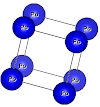Abstract:
The semi-local Becke-Johnson (BJ) exchange-correlation potential and its
modified form proposed by Tran and Blaha (TB-mBJ) have attracted a lot
of interest recently because of the surprisingly accurate band gaps they can deliver for many semiconductors and insulators. In this work, we have investigated the performance of the TB-mBJ potential for the description of electronic band structures in a comprehensive set of semiconductors and insulators.
We point out that a perturbative use of the TB-mBJ potential can give
overall better results. By investigating a set of IIB-VI and III-V semiconductors, we point out that although the TB-mBJ approach can describe the band gap of these materials quite well, the binding energies of semi-core d-states
in these materials deviate strongly from experiment. The difficulty of
the TB-mBJ potential to describe the localized states is likely the
cause for the fact that the electronic band structures of Cu 2O and La2O3 are still poorly described. Based on these observations, we propose to combine the TB-mBJ approach with the Hubbard U correction for localized d/f states, which is able to provide overall good descriptions for both the band gaps and semi-core states binding energies. We further apply the approach to calculate the band gaps of a set of Ti(IV)-oxides, many of which have complicated structures so that the more advanced methods like GW
are expensive to treat directly. An overall good agreement with
experiment is obtained, which is remarkable considering its little
computational efforts compared to GW.
To download the article click on the link below:










0 Comments